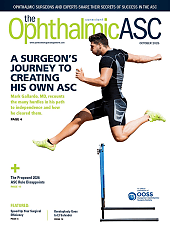Sight Sciences, Inc., published in the European Journal of Ophthalmology the results of a systematic review and meta-analysis of the clinical effectiveness, safety, humanistic, and economic impact of the Omni Surgical System (Omni).
The study assessed Omni as well as its predecessors, Visco360 and Trab360, for the treatment of open-angle glaucoma (OAG). The paper reports both standalone and combined treatments to be effective in achieving long-term, clinically significant reductions in intraocular pressure (IOP) and medication use, with sustained improvements over time, according to a company press release.
Omni enables an implant-free, ab interno minimally invasive glaucoma surgery (MIGS) procedure intended to restore aqueous outflow of glaucomatous eyes by addressing the 3 areas of outflow resistance associated with the disease. Investigators conducted a systematic literature review across MEDLINE, Web of Science, Cochrane (January 2016-April 2024), and congress proceedings (2021-2024) before performing a meta-analysis. Twenty-nine publications were included in the analysis, based on 22 studies and a total of 2,379 eyes. Twenty-seven publications reported clinical outcomes, while 2 focused on economic outcomes, the company said in the press release.
Key findings from the study showed that treatment success (IOP reduction ≥20% from baseline) was observed in approximately 89% of patients treated with either standalone or combined treatments after 6, 12, and 24 months. After 6 and 12 months, approximately 66-68% of patients treated with either standalone or combined treatments remained medication-free, the meta-analysis showed.
In addition, the study demonstrated that Omni significantly reduced IOP, with mean IOP below 18 mmHg at 12 months when used in combination with cataract surgery (11.5 to 17.2 mmHg for patients with baseline IOP ≥18 mmHg and 12.8 to 15.4 mmHg for patients with baseline IOP <18 mmHg). This trend continued at 24 months (range of 11.5 to 16.7 mmHg for patients with baseline IOP ≥18 mmHg and 13.7 to 14.0 mmHg for patients with baseline IOP <18 mmHg).
Meta-analysis confirmed comparable, statistically significant IOP reductions for standalone and combination therapy at 6, 12, and 24 months. Average IOP-lowering medication use decreased from a range of 0.9 to 3.4 medications at baseline to a range of 0.1 to 2.2 medications at month 12 (standalone and combination).
In addition, patients with a baseline IOP of ≥18 mmHg and <18 mmHg showed a statistically significant IOP reduction at 6 and 12 months. Mean IOP reduction was 6.4 to 10.0 mmHg at 12 months for patients with a baseline IOP ≥18 mmHg following combination and standalone surgery, while patients with a baseline IOP <18 mmHg following combination and standalone surgery saw a mean IOP reduction of 1.3 mmHg at 12 months.
The study also showed that both groups of patients with baseline IOP of ≥18mmHg and <18 mmHg benefit from statistically significant medication reductions; adverse events were generally mild and transient; and economic analyses indicate Omni is cost-effective.
Finally, the cost-utility analysis included quality of life (QoL) outcomes in the form of quality-adjusted life years (QALYs). The average QALYs per patient treated with Omni were 8.95 over a lifetime horizon and 1.59 over 2 years.








